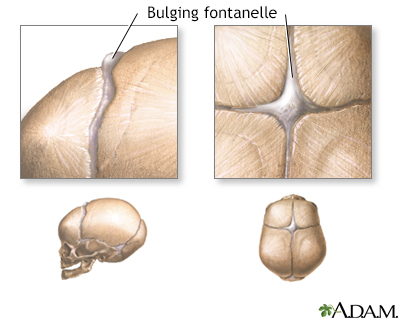Pregnancy SmartSiteTM
Soft spot - bulging; Bulging fontanelles DefinitionA bulging fontanelle is an outward curving of an infant's soft spot (fontanelle). ConsiderationsThe skull is made up of many bones. There are 8 bones in the skull itself and 14 bones in the face area. They join together to form a solid, bony cavity that protects and supports the brain. The areas where the bones join together are called the sutures. The bones are not joined together firmly at birth. This allows the head to change shape to help it pass through the birth canal. The sutures get minerals added to them over time and harden, firmly joining the skull bones together. In an infant, the space where 2 sutures join forms a membrane-covered "soft spot" called a fontanelle (fontanel). The fontanelles allow for growth of the brain and skull during an infant's first year. There are normally several fontanelles on a newborn's skull. They are located mainly at the top, back, and sides of the head. Like the sutures, fontanelles harden over time and become closed, solid bony areas.
The fontanelles should feel firm and very slightly curved inward to the touch. A tense or bulging fontanelle occurs when fluid builds up in the brain or the brain swells, causing increased pressure inside the skull. When the infant is crying, lying down, or vomiting, the fontanelles may look like they are bulging. However, they should return to normal when the infant is in a calm, head-up position. CausesReasons a child may have bulging fontanelles include:
Home CareIf the fontanelle returns to normal appearance when the child is calm and head-up, it is not a truly bulging fontanelle. When to Contact a Medical ProfessionalImmediate, emergency care is needed for any infant who has a truly bulging fontanelle, especially if it occurs along with fever or excess drowsiness. What to Expect at Your Office VisitThe health care provider will perform a physical exam and ask questions about the child's medical history, such as:
Diagnostic tests that may be done are:
ReferencesGoyal NK. The newborn infant. In: Kliegman RM, St. Geme JW, Blum NJ, Shah SS, Tasker RC, Wilson KM, eds. Nelson Textbook of Pediatrics. 21st ed. Philadelphia, PA: Elsevier; 2020:chap 113. Rosenberg GA. Brain edema and disorders of cerebrospinal fluid circulation. In: Jankovic J, Mazziotta JC, Pomeroy SL, Newman NJ, eds. Bradley and Daroff's Neurology in Clinical Practice. 8th ed. Philadelphia, PA: Elsevier; 2022:chap 88. Schnapp BH, Jewell C. Central nervous system infections. In: Walls RM, ed. Rosen's Emergency Medicine: Concepts and Clinical Practice. 10th ed. Philadelphia, PA: Elsevier; 2023:chap 95. | |
| |
Review Date: 1/24/2023 Reviewed By: Neil K. Kaneshiro, MD, MHA, Clinical Professor of Pediatrics, University of Washington School of Medicine, Seattle, WA. Also reviewed by David C. Dugdale, MD, Medical Director, Brenda Conaway, Editorial Director, and the A.D.A.M. Editorial team. The information provided herein should not be used during any medical emergency or for the diagnosis or treatment of any medical condition. A licensed medical professional should be consulted for diagnosis and treatment of any and all medical conditions. Links to other sites are provided for information only -- they do not constitute endorsements of those other sites. No warranty of any kind, either expressed or implied, is made as to the accuracy, reliability, timeliness, or correctness of any translations made by a third-party service of the information provided herein into any other language. © 1997- A.D.A.M., a business unit of Ebix, Inc. Any duplication or distribution of the information contained herein is strictly prohibited. | |

 Skull of a newborn
Skull of a newborn Bulging fontanelle
Bulging fontanelle
